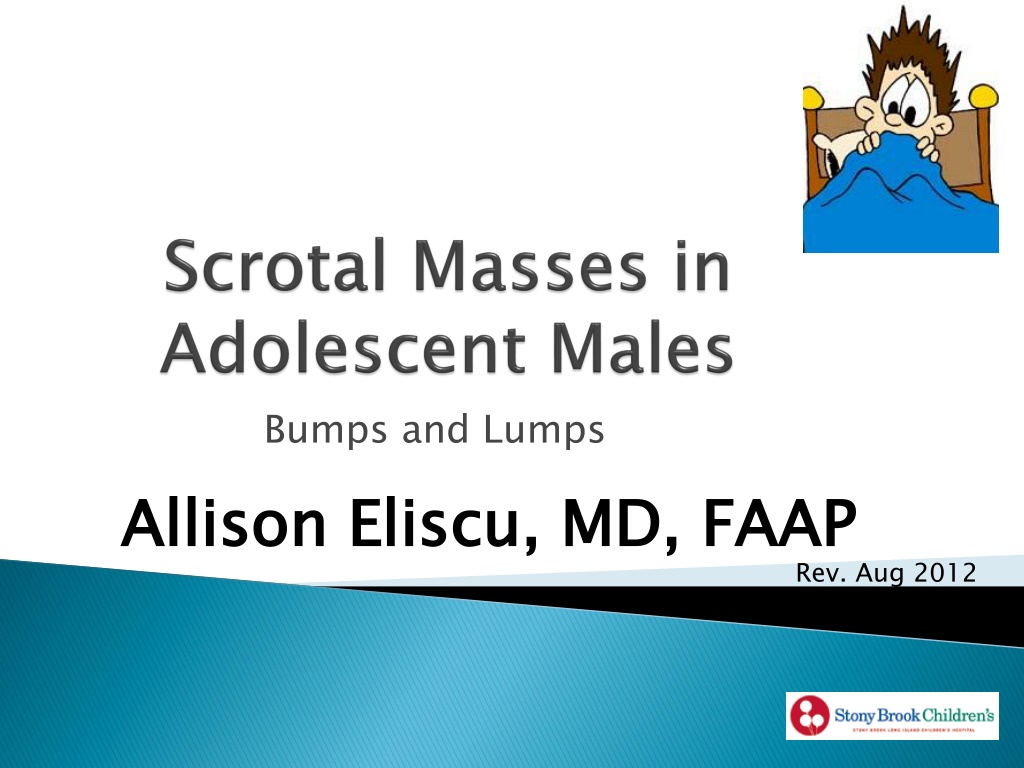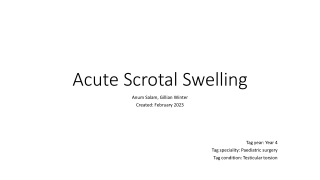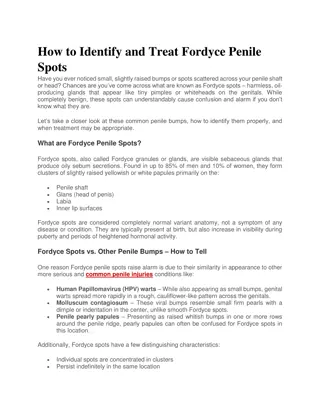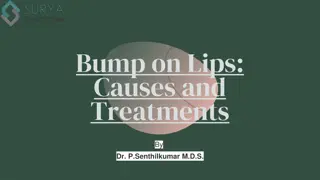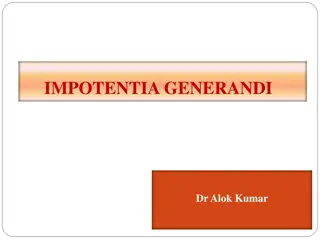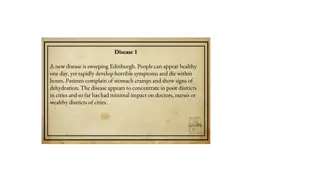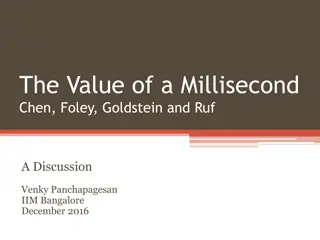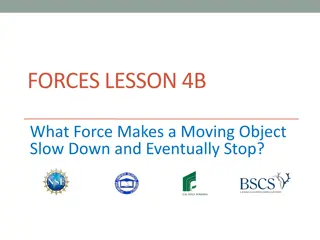Understanding Scrotal Bumps and Lumps: Hydrocele and Spermatocele
Scrotal bumps and lumps such as hydrocele and spermatocele are common conditions among males, particularly adolescents. Hydrocele, a collection of fluid in the layers of the scrotum, usually presents as painless swelling and may be idiopathic or secondary to various causes. On the other hand, spermatocele is a painless retention cyst of the epididymis that may contain dead sperm. Both conditions can usually be diagnosed through physical examination and may not require treatment. It's important to differentiate them from other more serious conditions like infection, torsion, or malignancy.
Download Presentation

Please find below an Image/Link to download the presentation.
The content on the website is provided AS IS for your information and personal use only. It may not be sold, licensed, or shared on other websites without obtaining consent from the author. Download presentation by click this link. If you encounter any issues during the download, it is possible that the publisher has removed the file from their server.
E N D
Presentation Transcript
Bumps and Lumps Allison Eliscu, MD, FAAP Allison Eliscu, MD, FAAP Rev. Aug 2012
Collection of fluid between the layers of tunica vaginalis Most common cause of painless scrotal swelling Extremely common in adolescent males Usually noncommunicating hydrocele (processus vaginalis closed) Frequently idiopathic May be secondary to orchitis, epididymitis, testicular torsion, or tumor Hydrocele
Usually incidental finding on examination Usually asymptomatic unless associated with trauma, torsion, or infection Patients may complain of dragging sensation
Soft, painless, fluctuant mass Anterior to testicle typically Communicating hydrocele Smaller with lying down Larger with valsalva maneuver Noncommunicating unchanged with maneuvers Transilluminates Transillumination light through the scrotum and clear fluid of a hydrocele Transillumination transmission of
No ultrasound required if able to palpate entire testicle Must be able to exclude infection, torsion, or malignancy otherwise need ultrasound Secondary hydroceles resolve with treatment of underlying issue Majority of idiopathic hydroceles self-resolve Athletic Supporter for pain with exercise
Painless retention cyst of epididymis Usually contains dead spermatzoa Incidence <1% Located superior and posterior to testicle Small, painless, mobile Transilluminates Spermatocele
Diagnosis may be made by physical exam May need ultrasound to confirm diagnosis No treatment necessary
Tortuous veins of pampiniform plexus Present in 15-20% of adolescent males 85-90% on left side Likely due to venous drainage patterns of spermatic veins
Typically asymptomatic incidental finding on physical exam Patients may complain of dull ache or fullness Feels like bag of worms above testicle Larger with valsalva maneuver Smaller in supine position May develop testicular atrophy on affected size
80% of adult males w/ varicocele have normal fertility BUT 40% of infertile men have varicocele Impaired venous circulation may decrease quality of sperm
Determine testicular volume Physical exam or ultrasound (most accurate) Decreased volume indicates decreased spermatogenesis More accurate indicators of fertility: **These are not recommended routinely yet, still undergoing research to determine if should be routine** Basal LH and FSH levels - elevated levels indicative of problem Semen analysis
Large varicocele with small testicle >2-3 mL difference in testicle volume by U/S Bilateral or symptomatic varicoceles Scrotal Pain Testicular size 2 S.D. below normal Abnormal semen analysis Elevated basal LH and FSH levels Unnecessary Surgery Infertility
Most common solid cancer in 15-34 yo males Risk factors: Cryptorchidism (undescended testicle)* Family history of testicular cancer HIV infection Prior germ cell tumor (intra or extragonadal) Prior tumor in contralateral testicle History of mumps orchitis Trauma * Most significant risk factor
Most significant risk factor for developing testicular cancer Patients with history of cryptorchidism 2.5-11 times higher risk of cancer BUT only 1-5% pts w/ prior undescended testis actually develop cancer (not 100%) Incidence may be decreased by early orchiopexy BUT 90% of germ cell tumors occur in patients with NO history of cryptorchidism
History: Painless mass found on exam Dull achy feeling or heaviness (30-40%) Acute testicular pain (10%) due to hemorrhage or infarction) Physical Exam: Firm, nontender mass Does not transilluminate Reactive hydrocele may be present
Testicular ultrasound is very accurate test If U/S unequivical, testicular MRI may help determine if mass is benign or malignant Chest X-ray CT scan of abdomen and pelvis Immediate referral to urologist or oncologist Look for metastases
Why is it controversial? Specificity, sensitivity, and PPV unknown Does not appear to change mortality incidence of disease and high survival rates We recommend teaching males >15 yo how to do exam and encouraging monthly exams *Stress importance in patients with risk factors How to do self-exam? Best done after warm shower to relax scrotal tissue Roll testicle between thumb and index/middle fingers Feel for lumps, hardness, or thickness Compare to last exam and opposite side mortality due to low
Germ Cell Tumors (95%) 95% of testicular tumors Seminomas Nonseminoma * 40% of germ cells * Peak 25-45 yo * 25% w/ mets at dx * 0% AFP+, 9% HCG+ * Slightly higher survival * Embryonal, teratoma, yolk sac, choriocarcinoma * Peak 15-30 yo * 60-70% w/ mets at dx * 65% AFP+, 56% HCG+
Keep normal anatomy in mind as you go through a genital exam
A. Varicocele B. Hydrocele C. Testicular tumor D. Spermatocele E. Unable to make a guess without a testicular ultrasound
A. Varicocele B. Hydrocele C. Testicular tumor D. Spermatocele E. Unable to make a guess without a testicular ultrasound
Answer: B. mass anterior to the testicle with a completely normal adjacent testicle which is consistent with a hydrocele. This mass transilluminates (light passes through it) which is also consistent with a hydrocele. A varicocele is superior to the testicle and does not transilluminate. Testicular tumors are not able to be separated from the testicle and do not transilluminate. Spermatoceles are usually superioposterior to the testicle and may transilluminate since they are fluid filled. Answer: B. This patient has a small, asymptomatic
A. Reassurance that this is normal and recheck in a few months B. Recommend sperm analysis to check fertility C. Immediate referral to urologist for ligation of varicocele D. Empirically treat him for gonorrhea and chlamydia
A. Reassurance that this is normal and recheck in a few months B. Recommend sperm analysis to check fertility C. Immediate referral to urologist for ligation of varicocele D. Empirically treat him for gonorrhea and chlamydia
Answer: A. adolescents which are frequently asymptomatic and incidentally found on exam. There is less of a concern about fertility if the testicle on the affected side appears to be the same size as the testicle on the unaffected side. If this is difficult to determine on exam, a testicular ultrasound should be performed to rule-out hypotrophy which would indicate decreased spermatogenesis. Patients with extremely large, symptomatic, or bilateral varicoceles should be referred to a urologist for evaluation and management. They may recommend a sperm analysis or LH/FSH levels to check fertility levels. Gonorrhea and chlamydia do not cause varicoceles. Answer: A. Varicoceles are common masses in
A. Reassurance that this is normal and recheck it in a few months B. Immediate referral to urologist C. Testicular ultrasound D. Empirically treat him for gonorrhea and chlamydia
A. Reassurance that this is normal and recheck it in a few months B. Immediate referral to urologist C. Testicular ultrasound D. Empirically treat him for gonorrhea and chlamydia
Answer: C. which can not be separated from the testicle and does not transilluminate is a testicular tumor until proven otherwise. This patient should have an immediate ultrasound to get more information about the mass followed by an immediate referral to a urologist or oncologist for further management. This should not wait a few months. If you suspect epididymitits (painful mass superoposterior to the testicle with dysuria and possibly urethral discharge), then the patient should be empirically treated for gonorrhea and chlamydia. However this patient s examination is not consistent with epididymitis. Answer: C. A nontender, indurated testicular mass
Brenner JS, Ojo A. Causes of Painless Scrotal Swelling in Children and Adolescents. UpToDate Online. Updated February 2, 2009. Adelman WP, Joffe A. Controversies in Male Adolescent Health: Varicocele, circumcision, and testicular self-examination. Curr Opin Pediatr. 2004 Aug;16(4):363-7. Diamond DA. Adolescent Varicocele. Curr Opin Urol. 2007;17:263-7. Rubenstein RA, Dogra VS, Seftel AD, Resnick MI. Benign Intrascrotal Lesions. J Urol. 2004 May;171(5):1765-72.
